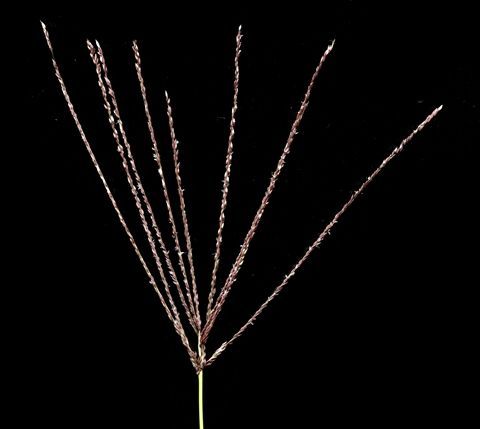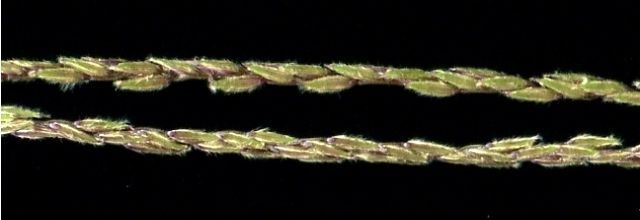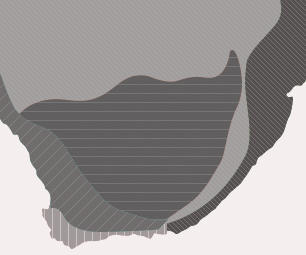Digitaria eriantha
Digitaria eriantha Steud.
Family: Poaceae
Common names: common finger grass, digit grass, giant pangola grass, Pongola finger grass, Smuts finger grass; woolly finger grass (Eng.); kortbeenhoenderspoor, kruisgras, Smutsvingergras, wolvingergras, (Afr.); isikonko (isiZulu); mangole maseka (Setswana); mmoyane, moeane ( Sesotho).
Introduction
Digitaria eriantha is a hardy, evergreen, tall grass distinguished by its special brown, digitate inflorescence, which is a feature of this species.

Description
Description
Digitaria eriantha is a fast-growing, perennial, sometimes stoloniferous, tufted grass, 350–1400 mm high. The rhizome is short, robust, knotty, unbranched. It often has long, hairy stolons.

The branched or unbranched culms are mostly hairless and their joints are usually brownish. The leaf blade is 50–400 × 2–14 mm; the blade is spreading, long, narrow, glabrous or hairy. The leaf sheaths are hairless (glabrous) or sparsely covered with tuberculose hairs.

Inflorescence a digitate (single whorl) or subdigitate (2 or more whorls) panicle comprising of 3–15 racemes, 50–200 mm long.

Spikelet 2.2–4.0 mm long, hairy; lower glume a membranous scale, ovate to triangular; upper glume 1/3–2/3 as long as spikelet, 3-nerved, hairy; internode absent; lower lemma as long as spikelet, oblong, 7-nerved, nerve smooth or sometimes scaberulous, upper glume and lower lemma covered with purple and silver hairs up to 1 mm long; upper lemma shorter than spikelet, greenish to brown, partly exposed; anther 1.8–2.2 mm long.

Seeds are small, and have a seed count of 3.3 million seeds/kg. Its greenish seed-heads consist of 3–10, fine branches arranged along a short section of stem, less than 50 mm long. It flowers in mid to late summer, from January to April.
Conservation Status
Status
According to the Red list of South African plants, Digitaria eriantha is not threatened and has been assessed as Least Concern (LC). The population is stable and not endangered. Although it is reported as invasive in few countries, it is not considered a serious threat where it is naturalized.
Distribution and habitat
Distribution description
Digitaria eriantha is distributed in Angola, Zimbabwe and Mozambique; it is dominant throughout South Africa where it occurs in Limpopo, North West, Gauteng, Mpumalanga, Free State, KwaZulu-Natal, and the Northern, Western and Eastern Cape Provinces. It also occurs in Namibia, Botswana, Eswatini (former Swaziland) and Lesotho. It is native in southern Africa, but cultivated as a pasture grass in other countries.
This grass grows in sandy and gravelly soil in the more arid parts and in damp soil such as beside vleis, in areas with a high rainfall ranging from 700 to 4 000 mm/year, temperature from 15.9 to 27.8ºC and soil pH from 4.3 to 8.5. This grass is tolerant of drought, but low rainfall is the main limiting factor for production range and yield. The best yields have been recorded from full sun or well-drained, moist soils. It mainly grows in undisturbed veld. It is also tolerant of fire.
Derivation of name and historical aspects
History
Digitaria is derived from digitus, the Latin word for ‘finger’, referring to the long, finger-like inflorescences produced by the grasses. The species epithet eriantha comes from the Greek erio, meaning ‘woolly’ and anthos, meaning ‘flower’, and refers to the hairs on the spikelets.
It is a very variable grass with many forms, very closely related to and intergrading with D. natalensis, D. milanjiana and D. seriata. Today it is distributed in many humid subtropical and tropical areas.
The genus Digitaria has about 230 species, cosmopolitan, mainly in tropical and warm temperate regions. About 36 naturalized and indigenous species occur in southern Africa. They are widespread. The common name crabgrass is applied to many species in this genus.
Ecology
Ecology
Digitaria eriantha reproduces by means of seeds, and also vegetatively through stolons, its creeping runners. Its seeds may be spread by water and animals. The stolons spread laterally, enabling this species to form large colonies. Seeds are usually not viable or have low percentage viability. When reproducing by seeds, avoidance of competition in the early stages is needed. Seeding types tend to be restricted to sandy soils in their native habitat, possible because seedlings do not establish readily on heavier soils without disturbance. Both tufted and stoloniferous seeding types are mostly used on sandy soil in cultivation, although they will grow on clay soils, once established. Because of its fluffy seeds, it should be established in a well-prepared, firm seedbed. Proper rolling before and after seeding will benefit germination and establishment. Seeding varieties are mostly used in areas with rainfall from about 750–1 000 mm. Once established, however, they have the capacity to thicken up and spread from the sown area. Attracts mammals and birds once it flowers.

Uses
Use
It is regarded as one of the best natural and cultivated pastures. The best known cultivar is ‘Smuts finger grass’ in southern Africa. This grass demonstrates great potential for farmers in Africa in subtropical and tropical climates, mostly for livestock feed. Stolons are established to control soil erosion or good ground cover for soil conservation. It is used extensively for heavy grazing in summer, as forage for horses, sheep, cattle and lactating cows in winter and can grow very quickly. Utilized as standing hay or silage making, mostly with nitrogen fertilization rather than a companion legume. It is very palatable for livestock and it is also reported as an excellent species for beef and milk production. As a social benefit, Digitaria eriantha is used to induce labour and to treat external sores and wounds. The racemes are used as hair decorations. The fibres are used for baskets and in craftwork.
Growing Digitaria eriantha
Grow
This grass can grow in a variety of soils, ranging from sands to heavy clay. However, seeds are better adapted to sandy loam soil, compared to heavier soils, because seedling establishment is easier. Once established, seedlings can grow vigorously on clay soils. It is seed propagated. The seeds require a clean seedbed for establishment and all seed needs to be evenly distributed when sowing, in order to reduce competition in their early stages. Seed is slightly hairy and may not flow readily through some planting equipment. Mixing seed with superphosphate, or sawdust or pelleting facilitates flow. Stoloniferous types establish more readily than tufted ones. Digitaria eriantha grass has low to moderate salt/alkalinity tolerance and moderate tolerance of aluminium. This grass thrives in warm, moist environments, where it will generally grow very quickly. The ideal rainfall requirement is estimated to be 450 mm and for seeds about 750 mm. The grass responds well to nitrogen and will persist on infertile soils, but yields will be low. The estimated appropriate soil pH is >4.2. The ideal condition for the digit grass is full sun and well-drained, moist soils. The sufficient amount of nitrogen fertilizer is estimated at between 100 and 300 kg/ha N. This amount should be applied at different times, rather than a single application at the start of the season. It is also important to monitor levels of phosphorus and other nutrients throughout the entire growing season. As it grows fairly quickly with sufficient sunshine, it preferably needs to be grazed every 2 to 3 weeks.
Since the seed is fairly expensive, farmers are advised to produce their own seed so that further establishment can be made from their own seed supply. The right time to cut the inflorescence is when the seedhead colour changes from bluish purple to a grey and the lower seeds on the inflorescence have started dropping. The inflorescence can be cut either with an ordinary cutter or by hand. The harvested material is then spread under cover on a cement floor for further drying, after which a tractor is driven backwards and forwards over the cut material, so as to let the seed drop to the floor. The seed can be put through further cleaning processes, but all waste material can be scattered over poor patches in the grass. Once the seed crop has been removed from the land, a lot of leafy material remains to be used as grazing. It can be sown into veld having poor composition or having bare patches, since the grass is palatable. It is important to rest the grass pasture from January so as to allow it to grow for the rest of the season. In a dry year, growth may be required to accumulate sufficient roughage, whereas in an above rainfall year, the growth may be excessive.
Digitaria eriantha is susceptible to the rust Puccinia oahuensis which is a widespread disease found in America and Australia. This varies among genotypes. The most serious disease of D. eriantha is pangola stunt virus (PSV), a dwarfing disease which has seriously reduced the usefulness of the grass. There have been some genotypes that have demonstrated some resistance to this disease. This grass is attacked by white-backed plant hopper Sogatella furcifera. Symptoms of an infected grass are stunting, yellowing, reddening, twisting of leaves, swelling of small veins, and excessive tillering. There are insects and pests affecting Digitaria eriantha, they are as follows: spittlebugs (Tomaspis flavopicta, T. humeralis, Prosapia bicincta.), Rhodes grass mealy bug (Antonina graminis), chinch bug (Blissus leucopterus), sugar-cane aphid (Sipha flava), armyworms, root-knot nematodes and smut fungi. Normally it is the grass seedhead that will be infected and only under humid conditions.
References
- Atlas of living Australia Database, Species profile: Digitaria eriantha. https://bie.ala.org.au/species/http://id.biodiversity.org.au/node/apni/2899120 Accessed 06 Feb 2020.
- CABI, Invasive Species Compendium. Datasheet: Digitaria eriantha. https://www.cabi.org/isc/datasheet/109594 Accessed on 05 Feb 2020.
- Fish, L. & Victor, J.E. 2005. Digitaria eriantha Steud. National Assessment: Red List of South African plants version 2017.1. Accessed on 2020/06/03.
- Fish, L., Mashau, A.C., Moeaha, M.J. & Nembudani, M.T. 2015. Identification guide to southern African grasses. Strelitzia 36: 271–276. South African National Biodiversity Institute, Pretoria.
- Leistner, O.A. (ed.). 2000. Seed plants of southern Africa: families and genera. Strelitzia 10. National Botanical Institute, Pretoria.
- PROSEA Plant Resources of South-East Asia: Digitaria eriantha. https://uses.plantnetproject.org/e/index.php?title=Digitaria_eriantha_(PROSEA)&oldid=220964 Accessed on 06 Feb. 2020.
- Tikam, K., Phatsara, C., Mikled, C. et al. 2013. Pangola grass as forage for ruminant animals: a review. SpringerPlus 2: 604. https://doi.org/10.1186/2193-1801-2-604.
- Tropical Forages, Factsheets: Digitaria eriantha http://www.tropicalforages.info/key/forages/Media/Html/entities/digitaria_eriantha.htm. Accessed on 05 Feb. 2020.
- USDA, Natural Resources Conservation Service, Plants Database: Digitaria eriantha. http://plants.usda.gov. Accessed on 4 Feb 2020.
- Van Oudtshoorn, F. 1999. Guide to the grasses of southern Africa. Briza Publications, Pretoria.
- Weeds of Australia, Queensland Government fact sheet: Digitaria eriantha subsp. pentzii. https://keyserver.lucidcentral.org/weeds/data/media/Html/digitaria_eriantha.htm Accessed on 05 Feb. 2020.
- Wildflower Nursery, Indigenous Plant Database: Digitaria eriantha. https://wildflowernursery.co.za/indigenous-plant-database/digitaria-eriantha/ Accessed on 31 January 2020.
Credits
Shirinda Creselda Nyeleti and Aluoneswi Caroline Mashau
National Herbarium (PRE), Pretoria
July 2020
Images by Frits van Oudtshoorn
Plant Attributes:
Plant Type: Grass
SA Distribution: Eastern Cape, Free State, Gauteng, KwaZulu-Natal, Limpopo, Mpumalanga, North West, Northern Cape, Western Cape
Soil type: Sandy, Clay, Loam
Flowering season: Early Summer
PH:
Flower colour: Brown
Aspect: Full Sun
Gardening skill: Easy
Special Features:
Horticultural zones











Rate this article
Article well written and informative
Rate this plant
Is this an interesting plant?
Login to add your Comment
Back to topNot registered yet? Click here to register.